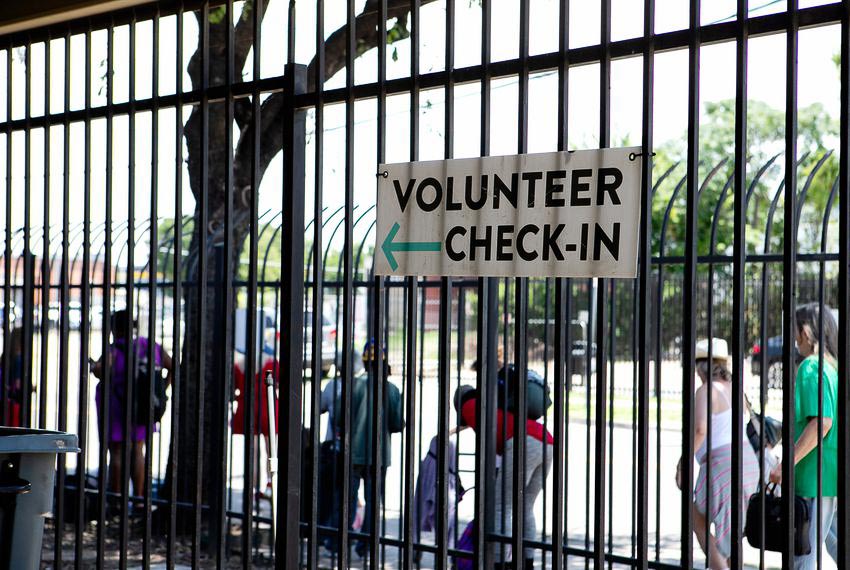This story was originally published by The Texas Tribune on July 2, 2019.
Back in the 1990s, Houston's urban core looked very different than it does today, with restaurants and coffee shops mingled among a burgeoning number of high-rise residences downtown. The city's bayous hadn't yet been beautified, with the clean biking and running trails that now wind through parks.
Back then, the bayous were a refuge for the city's homeless residents. And downtown, a multitude of organizations served food or offered beds, often without a lot of coordination with one another.
“Everybody was walking down the streets of downtown to get to the soup kitchen or to the day shelter,” Thao Costis, president and CEO of the homeless outreach organization SEARCH, remembers. “Church groups would have clothing or a fast lunch for them. It was very reactionary to these basic needs.”
But things have radically changed. While redevelopment has maybe made homelessness more visible to the urban core's new residents, the numbers show a 53% decrease in the Houston area's homeless population since 2011. This is according to the Point-in-Time count, a census that is done at the end of each January across the country, including in 11 urban areas of Texas. Although it is extremely difficult to count the homeless community in a precise way, experts agree that this process gives a good snapshot that allows people and governments to analyze general trends, and Houston’s numbers look exceptionally low.
In the meantime, other Texas cities, like San Antonio, Fort Worth and Austin – which recently passed an ordinance that allows sitting and camping in public – are experiencing increases in the number of residents who don't have a home. And such an increase is especially dramatic in Dallas, which according the 2019 Point-in-Time count, saw its homeless population surpass Houston's.
These counts can vary each year depending on how meticulously they are conducted, and some cities have experienced increases once they’ve perfected the methodology, like the Dallas area did in 2015. But no one denies that the rising number of homeless people is a growing problem in this city and its surrounding region.
“If you look at our percentage of growth over the last three years [from 2015 to 2018] it is higher than most of the other cities in the country. It is really alarming,” said Wayne Walker, executive director of the Dallas faith-based homeless organization Our Calling. “If you see our Point-in-Time count compared today to what we had last year, Dallas has more homeless people than any city in the southern U.S. except for Phoenix.”

Source: The Texas Tribune
So how do the two most populated regions in the state tell such different stories?
“It's very perplexing to be honest, because you have leaderships in both communities that are very concerned with the issue,” said Eric Samuels, president and CEO of the Texas Homeless Network. “In Houston, the former mayor Annise Parker made it a priority to end homelessness. [Current Houston Mayor] Sylvester Turner has also made it a priority. But you can't say that [former] Mayor [Mike] Rawlings, in Dallas, did not make it a priority, because he did.”
In Houston, the change in direction started in 2010.
The year before, while Dallas had counted 3,701 people on the street and in shelters, the number in Houston was 7,576. The Department of Housing and Urban Development then designated the Houston region as a priority community for assistance.
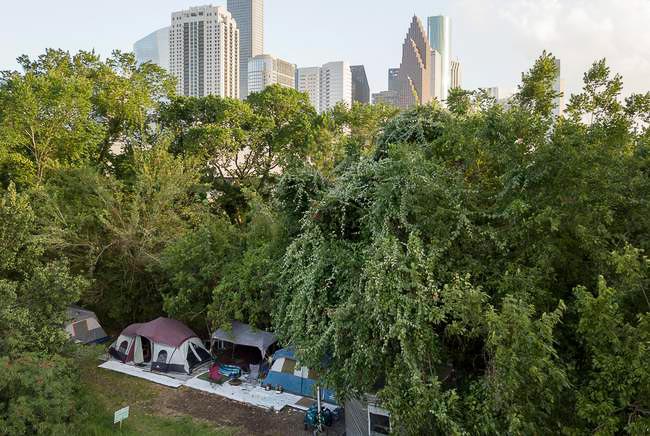
A large homeless camp near downtown Houston on June 23, 2019. Michael Stravato for The Texas Tribune
“Houston was notified by the HUD that we were not doing an adequate job on homelessness," said Mike Nichols, interim CEO of the Coalition for the Homeless in Houston, the local continuum of care, which is the regional planning body that coordinates housing and services funding for homeless people. “We became a test site, with tremendous help from HUD.”
Things didn’t improve right away. In 2011, Houston reached a peak of 8,471 people in the late January count. But the wheels were rolling. The organizations involved in the issue knew they needed to get the community united around the cause. They started a plan that first focused on military veterans, a group that represents roughly 9% of the homeless population nationally.
Organizers decided to challenge themselves to find housing for 100 veterans in 100 days.
At the time, it had been taking them around 220 days to find housing for a veteran. But they reached the goal of finding housing for 100 veterans in three months. The success gave them a credibility boost in the city.
“It was an early win. We got it and then we built around that,” Costis says.
In three years, Houston would house 3,650 veterans, in what would become a model at the national level.
The change was achieved with a lot of coordination between mayor Parker, HUD, police, businesses and around 100 organizations. Eva Thibaudeau-Graczyk, chief program officer of the Coalition for the Homeless, said the collaboration “brought new partners to the table with resources that had never been there before.”
Among them was the Houston Housing Authority. “Prior, they’ve never seen themselves as a leader or a main partner in ending homelessness,” Thibaudeau-Graczyk explained. But since then, this agency was key, allowing them to complement the funds for homelessness provided by HUD with the resources that were already available for affordable housing.
“This starts off with a simple dictate: the solution to homelessness is a home,” said Andy Icken, chief development officer for Turner, the current mayor. “Our focus was to create permanent supportive housing, so that we're not continually cycling people in and out of shelters, temporary or more permanent shelters.”
The good results translated into more funds from HUD, because part of that money was tied to performance. From 2008 to 2018, Houston added more than $18 million. To put that in perspective, in 2018 Dallas’ total funds from HUD were $16.5 million.
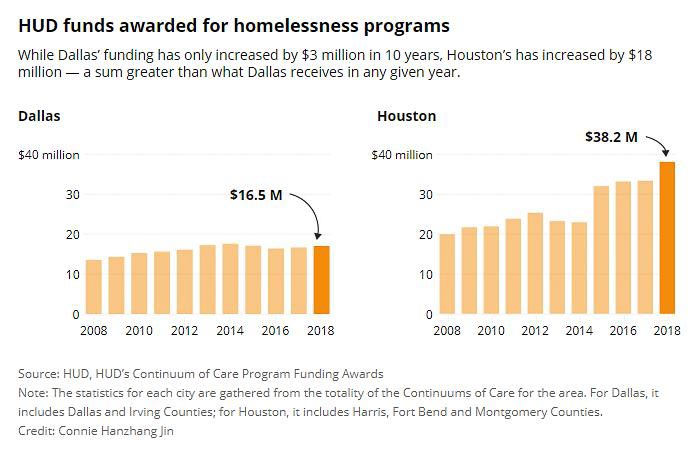
Source: The Texas Tribune
Although there are still challenges like the encampments in different parts of the city, since 2012 Houston has housed around 17,000 formerly homeless people, according to the Coalition for the Homeless. Many are connected with supportive services.
“If you have a homeless person and you put them in houses, and simultaneously give them social, behavioral and health support services, 92% of them will be stable in that facility,” Nichols said.
But there’s a hidden secret in Houston’s formula: coordination.
The scenario from 20 years ago when different organizations would serve food, give clothes or offer shelter — all done separately — has changed. There’s now constant communication between these institutions and a digital database called the Homeless Management Information System (or HMIS) that allows people at several organizations to understand each case. Most cities today have HMIS in place, but Houston was quick to adopt it, and that helped organizations strategize, analyze, share information and find personalized solutions.
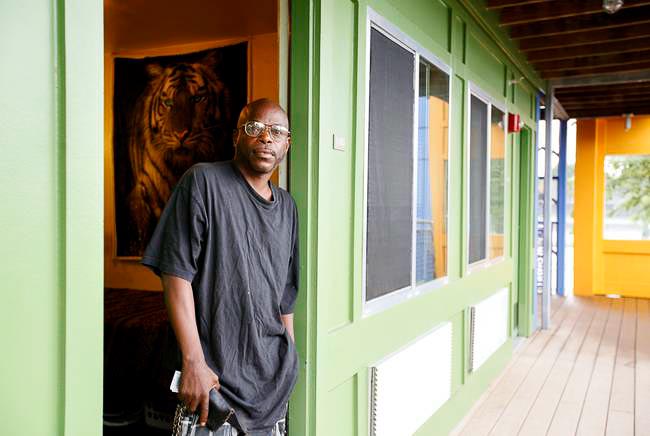
Percy Lyons in his temporary housing of four years in Houston on June 25, 2019. Source: Michael Stravato for The Texas Tribune
Around a decade ago, Percy Lyons arrived in Houston, hoping to live with his father.
“But his mental state wasn’t right," Lyons, now 44, said. "He turned his back on me.”
Lyons ended up living on the street. At some point, he applied for housing, but he never heard back from anyone, until a police officer saw him and decided to check what had happened with his case, in collaboration with SEARCH.
“They pulled out my information and saw everything,” Lyons said.
Thanks to this coordinated database, they could find what had happened — his case was "lost in the system," he says — and try to find a solution for him.
Now he has temporary housing and is on his way to having a permanent home.
“The difference of what is going on in Houston is its networks,” Lyons said.
The challenge of affordability in Dallas
Although he has worked with homeless people for more than two decades, Carl Falconer’s first Point-in-Time count in Dallas was this January. In November, he moved to Texas from Florida to become CEO of the Metro Dallas Homeless Alliance, the local continuum of care, which brings together around 85 shelters and programs in Dallas and Collin counties.
“One thing that stuck out there that night is that people in the streets did not have a sense of hope in the system," Falconer said. “They didn't have any confidence that they would be out of the streets any time soon."
It is difficult to separate this reality from the soaring Dallas real estate market, something that Houston is experiencing, but not to such intense degree. In the recently published Harvard report The State of the Nation’s Housing, the Dallas metro area is mentioned as having the highest volume of home sales in 2018 ($9.2 billion, the same as Los Angeles). But, also, the real home prices there have grown 42% between 2006 and 2018. Only Austin, Denver and San Francisco topped Dallas in this indicator.
“Our homelessness numbers reflect the increase in housing costs across the Metroplex,” said Daniel Roby, CEO of the Austin Street Center, one of the biggest shelters in the city.
He remembers coming to the center as a volunteer when he was 7 years old. At that time, suburban powerhouse Plano was practically grasslands. Now he says that he gets homeless people in the center from that city or other suburbs even farther out.
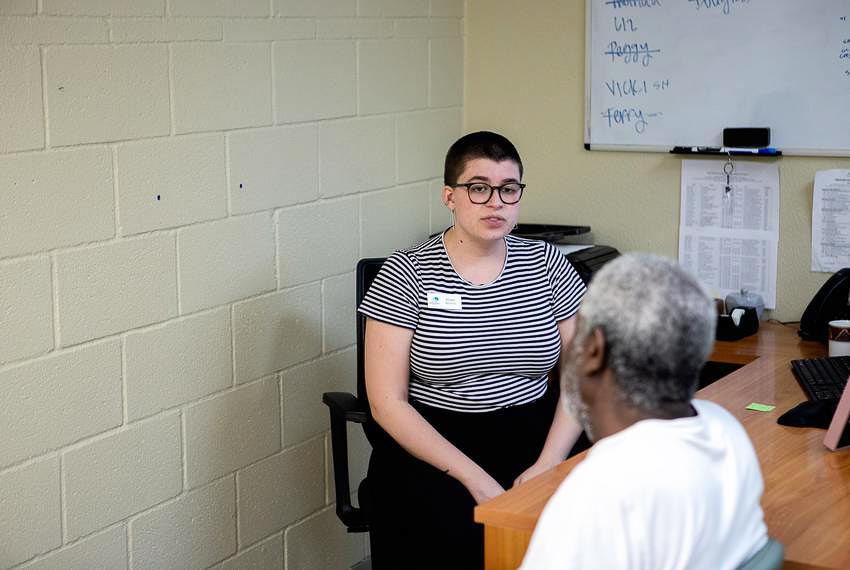
Hope Beaver, a complex needs case manager at Austin Street Center, speaks with a client who needs to visit the Social Security office for a new card, on June 25, 2019. Source: Leslie Boorhem-Stephenson for The Texas Tribune.
“Our Metroplex is massive compared to what it was then," he said. "But we have not grown our social service infrastructure. For the most part, we have the same number of beds now that we had then. Maybe we’ve added a few hundred beds, but our Metroplex has grown 10 times over.”
According to Monica Hardman, director of Dallas City Hall's Office of Homeless Solutions office, around three quarters of homeless people are “economically homeless,” which means they fell into homelessness due to some kind of unforeseen problem without a safety net. That includes situations like losing a job, having an unexpected health issue or an accident.
“One of the biggest factors is the housing conditions and the housing market here in Dallas. Is extremely hard to find housing that is affordable, especially if you are not making a living wage,” Hardman says.
For people like Carlton Nalley, who lives near Dallas City Hall and spends most days in the Downtown Branch of the Dallas Public Library, this isn't just about housing.
“The prices in general are going up,” said Nalley, who has been homeless since 2017, when he was released from federal prison. “Buying in the farmers market is like going to a shopping mall. You have to make three times the rent and that will give you a small place in a neighborhood where you won't feel safe.”
And the rapid redevelopment in the city's urban core could exacerbate things, especially since it is arriving in areas that weren’t as highly valued before and is replacing affordable units. Then there's another potential problem: expensive new residences' sudden proximity to existing shelters.
“Right behind us, probably within a matter of six months, there's going to be rents of $3,000 potentially for a one-bedroom unit,” said Rebecca Cox, chief services officer at The Bridge, one of the leading providers of homeless services in the city. “We are concerned that we are going to be seen as undesirable.”
But affordability isn’t the only problem in Dallas. Institutions play a role here, too.
Roby said Houston has some governmental advantages.
“They have a strong mayoral form of government," he said. While in Houston the executive power is in the hands of the mayor, in Dallas the mayor plays a role similar to a board chairman, with a city manager directing most departments and employees. "We [in Dallas] need to collaborate to get the support here, while there the mayor can just move on with the mayor’s agenda."
At the same time, Dallas has had a number of issues in terms of affordable housing. In March of last year, the Dallas Morning News discovered a case of corruption in a $825,000 contract to build and repair affordable units. And HUD has been conducting audits and the city might have to pay millions back for mismanaged funds.
Meanwhile, City Hall only got it first department dedicated to homelessness in 2017.
“For example, if there was a homeless encampment in a park, the parks department would do their best to clean it up and they would contact the police department if there was resistance, but there was no one really there as an advocate to be able to talk to the persons experiencing homelessness, and then to be able to link them to shelter and to services,” said Hardman.
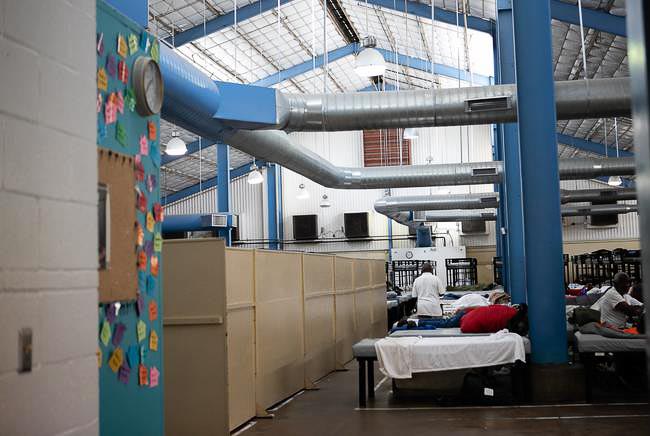
Inside Austin Street Center, an emergency homeless shelter serving Dallas, on June 25, 2019. The men's section is on the right and the women's section is enclosed by dividers on the left. The 400-bed shelter meets or nears capacity every day. Source: Leslie Boorhem-Stephenson for The Texas Tribune
And the Homeless Management Information System, a key part of Houston’s success, has had hiccups in Dallas. It’s going to be changed for a third time soon and the previous versions have been resisted by many in the community.
“It is exceptionally difficult to be able to have a high functioning collaborative system when you change it so often,” said Roby.
But nothing matters if Dallas doesn’t build affordable housing, Falconer said. The unsheltered homeless population has increased 725% from 2009 to 2019. The sheltered homeless population remains relatively stable because the number of beds at shelters have been the same for a long time.
“The unsheltered number is going up because the shelters are full,” Falconer said. “People don't have anywhere to go, they can't go to the emergency shelters and the reason why the emergency shelters numbers remain the same is because housing is not affordable and people can't move out of the shelter.”
Dallas needs more housing, especially what is called rapid rehousing, which includes a bed, services and financial assistance for short periods. City officials in the meantime have put in place a program with four tracks: They are paying a shelter $12 per night per bed for up to 90-day stays; they have been working to create shelters for inclement weather; they got $1.3 million in the 2019 fiscal year budget for rental subsidies and other housing assistance; and they plan to build or create 1,000 housing units over the next three to five years. For the last item, the City will be dedicating $20 million in bond funds and the request for developers interest was just released.
But Falconer is hopeful.
“One of the things that drew me to Dallas is that I really feel this is an opportunity to end homelessness here. Not manage it, not make it a little better, end it,” he says. “The resources that we have here, the community we have here, the providers that we have here, even the programs that they've already set up, we have a really good structure in place.”
"Why homelessness is going down in Houston but up in Dallas" was first published by The Texas Tribune, a nonprofit, nonpartisan media organization that informs Texans — and engages with them — about public policy, politics, government and statewide issues.

